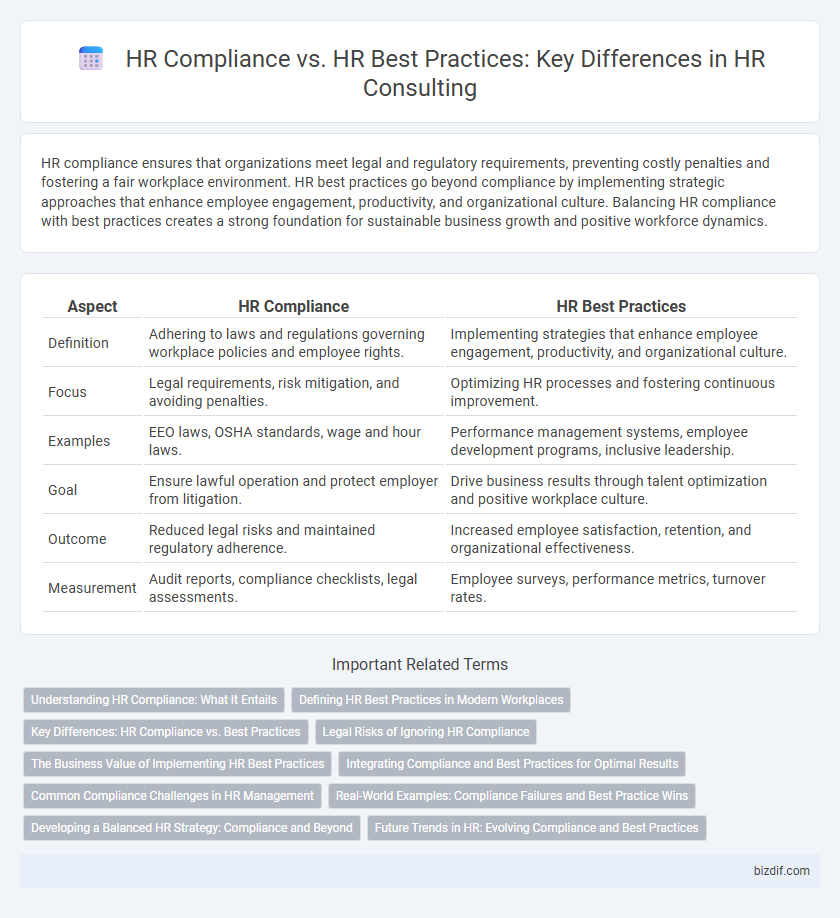HR compliance ensures that organizations meet legal and regulatory requirements, preventing costly penalties and fostering a fair workplace environment. HR best practices go beyond compliance by implementing strategic approaches that enhance employee engagement, productivity, and organizational culture. Balancing HR compliance with best practices creates a strong foundation for sustainable business growth and positive workforce dynamics.
Table of Comparison
| Aspect | HR Compliance | HR Best Practices |
|---|---|---|
| Definition | Adhering to laws and regulations governing workplace policies and employee rights. | Implementing strategies that enhance employee engagement, productivity, and organizational culture. |
| Focus | Legal requirements, risk mitigation, and avoiding penalties. | Optimizing HR processes and fostering continuous improvement. |
| Examples | EEO laws, OSHA standards, wage and hour laws. | Performance management systems, employee development programs, inclusive leadership. |
| Goal | Ensure lawful operation and protect employer from litigation. | Drive business results through talent optimization and positive workplace culture. |
| Outcome | Reduced legal risks and maintained regulatory adherence. | Increased employee satisfaction, retention, and organizational effectiveness. |
| Measurement | Audit reports, compliance checklists, legal assessments. | Employee surveys, performance metrics, turnover rates. |
Understanding HR Compliance: What It Entails
HR compliance involves adhering to legal regulations and standards set by governments and regulatory bodies to ensure workplace fairness, safety, and employee rights. Key elements include maintaining accurate records, following labor laws, implementing anti-discrimination policies, and ensuring proper wage and hour practices. Understanding these requirements helps prevent legal risks, promotes organizational integrity, and establishes a foundation upon which HR best practices can be effectively built.
Defining HR Best Practices in Modern Workplaces
HR best practices in modern workplaces emphasize proactive strategies that enhance employee engagement, diversity, and continuous development, surpassing mere compliance with labor laws and regulations. These practices integrate data-driven talent management, inclusive leadership, and adaptive performance metrics to foster a resilient and innovative organizational culture. Implementing HR best practices aligns workforce capabilities with business objectives, ensuring sustainable growth and competitive advantage.
Key Differences: HR Compliance vs. Best Practices
HR compliance involves adhering to mandatory labor laws and regulations such as the Fair Labor Standards Act (FLSA) and the Equal Employment Opportunity Commission (EEOC) guidelines to avoid legal penalties. HR best practices encompass strategic initiatives like talent development, employee engagement, and performance management that exceed legal requirements to enhance organizational effectiveness. Key differences lie in compliance being legally enforceable standards, whereas best practices serve as recommended frameworks for optimizing workforce productivity and culture.
Legal Risks of Ignoring HR Compliance
Ignoring HR compliance exposes organizations to significant legal risks, including costly lawsuits, regulatory fines, and reputational damage due to violations of labor laws such as the Fair Labor Standards Act (FLSA) and the Occupational Safety and Health Act (OSHA). Failure to adhere to mandatory HR compliance standards can result in employee discrimination claims, wage and hour disputes, and unsafe workplace conditions that jeopardize business continuity. Implementing robust HR compliance frameworks reduces legal exposure while aligning with industry best practices to promote a fair and lawful work environment.
The Business Value of Implementing HR Best Practices
Implementing HR best practices drives business value by enhancing employee engagement, reducing turnover, and improving productivity, which compliance alone does not guarantee. While HR compliance ensures adherence to legal standards and mitigates risks, best practices foster a positive organizational culture and support strategic talent management. Companies that integrate best practices into their HR functions experience stronger performance outcomes and sustained competitive advantage.
Integrating Compliance and Best Practices for Optimal Results
Integrating HR compliance with best practices ensures organizations meet legal requirements while fostering a productive work environment. Effective HR strategies combine regulatory adherence with employee engagement tactics, reducing risks and enhancing organizational culture. Aligning compliance frameworks with best practices optimizes talent management and supports sustainable business growth.
Common Compliance Challenges in HR Management
Common compliance challenges in HR management include navigating complex labor laws, ensuring accurate employee record-keeping, and maintaining consistent policy enforcement across diverse teams. Organizations often struggle with staying updated on evolving regulations such as the Fair Labor Standards Act (FLSA), Equal Employment Opportunity (EEO) guidelines, and Occupational Safety and Health Administration (OSHA) standards. Effective HR consulting addresses these challenges by implementing robust compliance frameworks that reduce legal risks while aligning with best practices for workforce management.
Real-World Examples: Compliance Failures and Best Practice Wins
Compliance failures often result from ignoring labor laws, such as misclassifying employees, which led to a $12 million settlement in the Uber case. Conversely, companies like Google implement best practices by promoting transparent communication and equitable policies, reducing turnover rates by 15%. Real-world examples show that aligning HR practices with regulatory compliance not only avoids costly penalties but also fosters employee satisfaction and retention.
Developing a Balanced HR Strategy: Compliance and Beyond
Developing a balanced HR strategy requires integrating HR compliance with best practices to optimize workforce performance and minimize legal risks. HR compliance ensures adherence to labor laws and regulations such as FLSA, FMLA, and EEOC guidelines, while HR best practices focus on talent development, employee engagement, and diversity initiatives. Combining these elements creates a sustainable HR framework that drives organizational success and fosters a positive workplace culture.
Future Trends in HR: Evolving Compliance and Best Practices
Future trends in HR emphasize the convergence of HR compliance and best practices, driven by increasingly complex labor laws and the integration of AI-powered analytics. Organizations are leveraging predictive compliance tools and employee-centric policies to proactively mitigate legal risks while enhancing workforce engagement. Embracing adaptive frameworks that align regulatory requirements with agile HR strategies ensures sustained organizational resilience and talent retention.
HR compliance vs HR best practices Infographic

 bizdif.com
bizdif.com